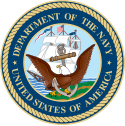Richard Best
 | |
| Data i miejsce urodzenia | |
|---|---|
| Data i miejsce śmierci | |
| Przebieg służby | |
| Lata służby | 1928–1944 |
| Siły zbrojne | |
| Główne wojny i bitwy | |
| Odznaczenia | |
Richard Halsey Best (ur. 24 marca 1910 w Bayonne, zm. 28 października 2001 w Santa Monica)[1] – komandor podporucznik pilot US Navy. Uczestnik wojny na Pacyfiku, odznaczył się bohaterstwem[1] w bitwie pod Midway. Absolwent United States Naval Academy, jedyny obok Normana Kleissa amerykański pilot, który w jednej bitwie trafił więcej niż jeden okręt wroga.
Bitwa pod Midway
W bitwie tej dowodził eskadrą Bombing Squadron Six (VB-6) pokładowych bombowców nurkujących lotniskowca USS „Enterprise” (CV-6) Douglas SBD Dauntless. W trakcie bitwy – w wyniku nieporozumienia – dwie amerykańskie eskadry zaczęły atakować jeden lotniskowiec – „Kagę”. Kapitan Best dostrzegł błąd dowodzącego Scauting Squadron Six (VS-6) Wade'a McCluskyego i przerwał atak, jednak prawie cała jego jednostka kontynuowała bombardowanie. Best oraz jego dwaj skrzydłowi – por. Edwin John Kroeger i ppor. Frederic Thomas Weber, zaatakowali „Akagi”. Z trzech bomb trafiła jedna, zrzucona przez Richarda Besta. Wybuchła na górnym pokładzie hangarowym, wśród przygotowywanych do ataku samolotów torpedowych[2]. Trafienie to doprowadziło do zagłady „Akagi”. Tego samego dnia, kapitan Best uczestniczył również w ataku na „Hiryu”. Bezpośrednio po bitwie został odznaczony najwyższym odznaczeniem bojowym marynarki, i drugim najwyższym w Stanach Zjednoczonych (po Medalu Honoru) Krzyżem Marynarki Wojennej (ang. Navy Cross) oraz Zaszczytnym Krzyżem Lotniczym (ang. Distinguished Flying Cross).
Była to jego ostatnia akcja bojowa. Podczas dolotu nad cel, testując aparat tlenowy, wciągnął do płuc niewielką ilość spalin i nazajutrz zaczął pluć krwią. Według diagnozy lekarskiej nastąpiło uaktywnienie gruźlicy utajonej, wskutek zatrucia gazami spalinowymi. Niezdolny do dalszej służby, został odesłany do szpitala.
Praca cywilna
Best odszedł z marynarki w 1944. Po kilkuletnim leczeniu podjął pracę w małej placówce badawczej, należącej do Douglas Aircraft Company, przekształconej później w RAND Corporation. Był tam szefem ochrony. Funkcję tę pełnił aż do przejścia na emeryturę w 1975.
Śmierć
Zmarł w 2001 i został pochowany na Narodowym Cmentarzu w Arlington.
Przypisy
- ↑ a b Veteran Tributes - Richard H. Best (ang.) [dostęp 2011-09-03]
- ↑ Jonathan Parshall, Anthony Tully, Shattered Sword: The Untold Story of the Battle of Midway, Washington 2005, ss. 241–242
Linki zewnętrzne
Media użyte na tej stronie
*Description: On a circular background of fair sky and moderate sea with land in sinister base, a tri-mast square rigged ship under way before a fair breeze with after top-sail furled, commission pennant atop the foremast, National Ensign atop the main, and the commodore's flag atop the mizzen. In front of the ship a luce-type anchor inclined slightly bendwise with the crown resting on the land and, in front of the shank and in back of the dexter fluke, an American bald eagle rising to sinister regarding to dexter, one foot on the ground, the other resting on the anchor near the shank; all in proper colors. The whole within a blue annulet bearing the inscription "Department of the Navy" at the top and "United States of America" at the bottom, separated on each side by a mullet and within a rim in the form of a rope; inscription, rope, mullet, and edges of annulet all gold. *Background: The policy for use of the Navy seal and emblem is contained in SECNAV Instr 5030.4 and SECNAV Instr 5030.6. The seal design was approved by the President of the United States by Executive Order 10736 dated October 23, 1957. Request for use of the Navy emblem should be submitted in writing to Defense Printing Service, ATTN: DPSMO, 8725 John Kingman Rd Suite 3239, Fort Belvoir, VA 22060-6220. The telephone number is (703) 767-4218. 1879 version here: http://etc.usf.edu/clipart/54900/54985/54985_seal_navy.htm
Naval Aviator insignia, worn by pilots in the U.S. Navy. See U.S. Navy Uniform Regulations: 5201 - Breast Insignia.
Ribbon from the Distinguished Flying Cross (United States) awarded by the United States Department of Defense.
Ribbon for the American Defense Service Medal awarded by the United States Department of Defense.
Ribbon for the Asiatic-Pacific Campaign Medal awarded by the United States Department of Defense.
Ribbon for the American Campaign Medal awarded by the United States Department of Defense.
Ribbon for the World War II Victory Medal awarded by the United States Department of Defense.
Ribbon for the Navy Cross awarded by the United States Department of the Navy.
Richard Halsey Best. Lieutenant Commander Richard Halsey Best, USN, (24 March 1910 – 28 October 2001), shown here as a Lieutenant, was a dive-bomber pilot in the United States Navy, mostly noted for his leadership of dive bomber squadron VB-6 during the Battle of Midway, 4-6 June 1942.
Naramiennik stopnia Lieutenant Commander (United States Navy).










